Syncopation is all about shifting the usual emphasis in a rhythm and playing around with strong and weak beats.
It can help your tracks stand out by creating unique and interesting rhythms that catch the listener’s ear and instantly reel them in.
Plus, syncopation adds depth and complexity 一 giving your music a more dynamic and engaging feel over your competition.
That’s why, as a producer, knowing all the answers to what is syncopation in music can seriously enhance your skills.
And luckily, we’re breaking down everything you need to know, like:
- Understanding syncopation basics ✓
- Weak beats, strong beats, off beats ✓
- Differences between syncopated rhythms & standard rhythms ✓
- Types of syncopation you can use ✓
- Offbeat and anticipated syncopation ✓
- How to use missed beat syncopation ✓
- Mastering suspension syncopation ✓
- Creating syncopated drum patterns ✓
- Working with syncopated notes ✓
- Syncopation in melodies and basslines ✓
- Advanced techniques for combining syncopation & polyrhythms ✓
- Much more to help you answer, ‘what is syncopation in music’ ✓
After this article, you’ll know everything about what is syncopation in music.
You’ll be able to confidently break down the different types and techniques, and understand exactly how to apply them in your tracks.
Plus, you’ll successfully add syncopated elements that elevate your music, making your songs more dynamic and captivating.
Your beats will always feel fresh and engaging, and your rhythms will be memorable, keeping your listeners coming back for more.
Let’s dive in…
Table of Contents
What is Syncopation in Music: Breaking Down the Basics
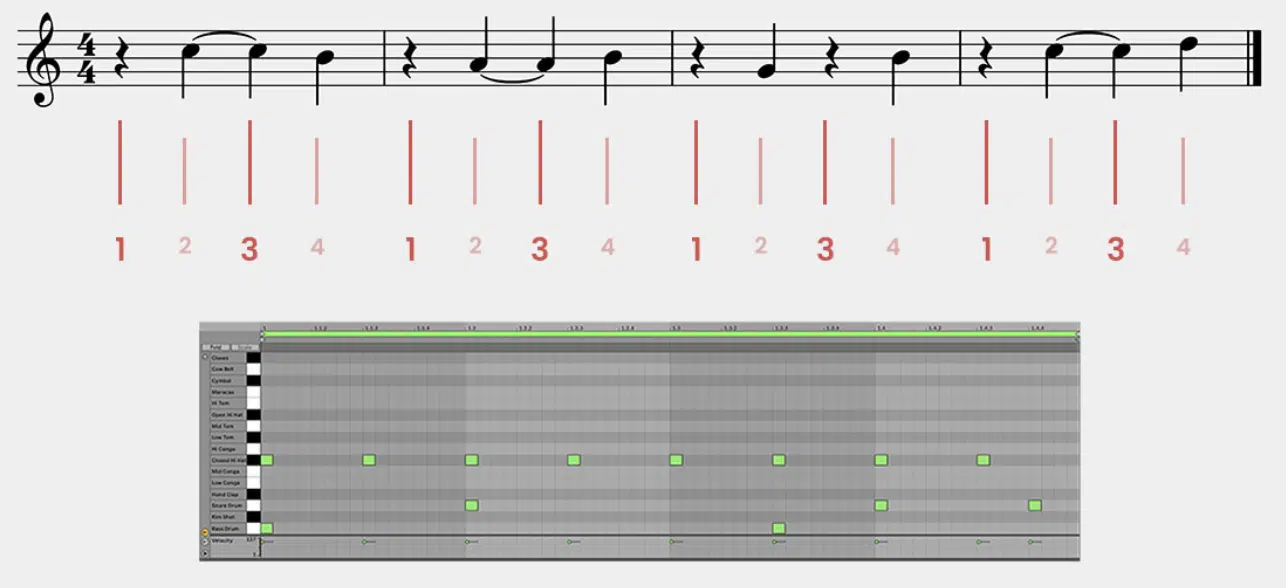
Syncopation in music is all about breaking away from the regular rhythm and creating interesting rhythms that catch the listener’s ear right away.
When someone asks, “What is syncopation in music?” you can sum it up by more emphasis on the weak beats than the strong beats.
It makes music feel more unpredictable and fresher, which is pretty intriguing.
In many genres, from electronic dance music to jazz and even classical, syncopated rhythms play a key role in defining the groove.
Unlike standard rhythms, where the focus is on the first and third beats in 4/4 time signatures, syncopation occurs when notes are played on the off beats or unexpected parts of the measure.
When you hear a syncopated rhythm, you’ll notice the beat feels slightly off-kilter, adding a unique texture and feel to the music.
Syncopation Rhythms vs. Standard Rhythms
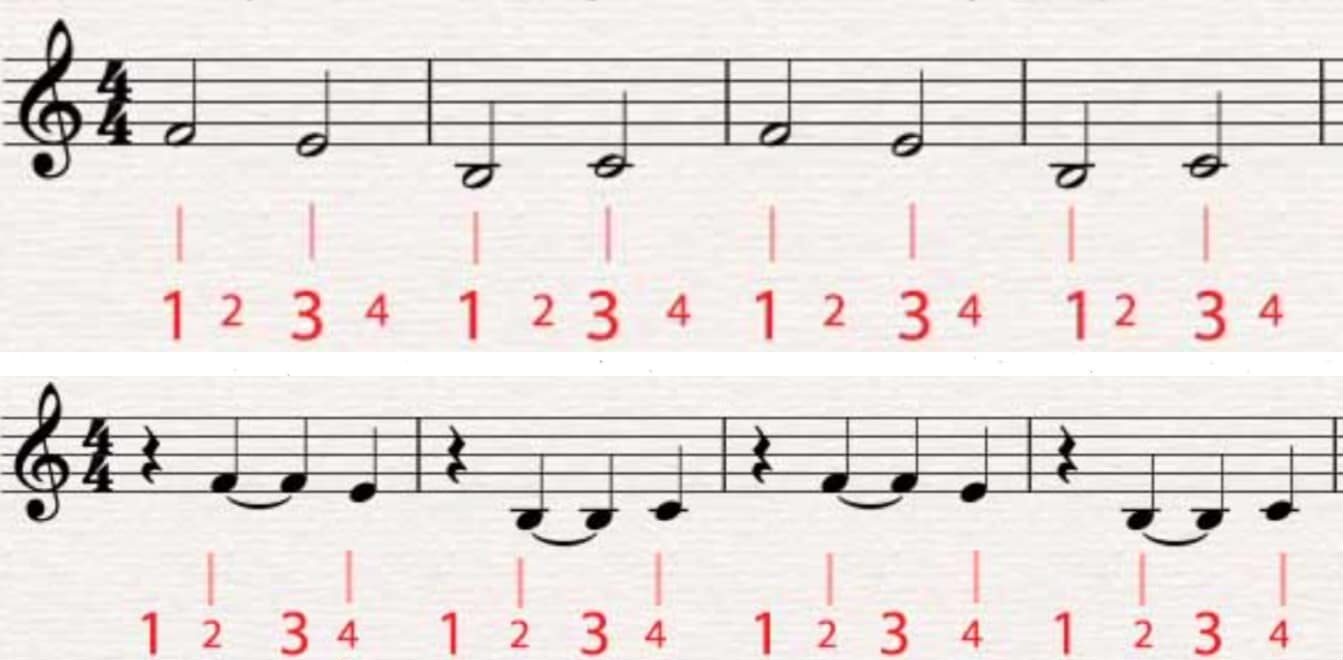
Top: Not Syncopated; Bottom: Syncopated
Understanding the difference between syncopation rhythms and standard rhythms is essential for creating engaging beats in any song.
In a standard rhythm, strong beats are emphasized, usually following a steady pattern that aligns with the first beat or the third beat of a measure.
This creates a steady beat that listeners can easily follow 一 it’s simple, straightforward, and predictable.
However, in syncopated music, the focus shifts to the off-beat, creating a rhythm that is way more dynamic and unexpected.
A simple example of syncopation might involve playing a note slightly ahead of the next beat or holding it longer than usual to create a sense of tension.
This unpredictability in the rhythm makes the music feel more alive and engaging, keeping the listener on their toes.
Don’t worry, we’ll explain syncopation in all its various forms (in detail) throughout the article.
Types of Syncopation in Music
Syncopation comes in many forms, each creating a distinct rhythmic feel that can transform a track. So, let’s kick things off by diving into the four main types of syncopation and seeing how they can add interesting rhythms to your music.
-
Offbeat Syncopation Rhythms

Eighth Note Off Beats
When trying to understand what is syncopation in music, one of the most commonly used techniques is offbeat syncopation.
This involves playing notes on the off beats (the “ands” between the main beats in a measure) rather than on the strong beats themselves.
For example, in a 4/4 time signature, rather than hitting a snare or clap on the second and fourth beats, you place them on the “and” counts.
It can create a feeling of propulsion or forward motion, especially in genres like reggae and funk, where the guitar or hi-hats often emphasize these off beats.
When layering your music, try using a hi-hat pattern with offbeat syncopation, then contrast it with a bassline that stays on the strong beats…
This can create a super interesting push and pull effect in your rhythm.
By experimenting with this technique, you can create syncopated rhythms that add depth and character to your songs, making them stand out even more.
Remember, when you’re trying to learn what is syncopation in music, it’s all about experimenting and playing around with different techniques and strategies.
-
Missed Beat Syncopation Rhythms
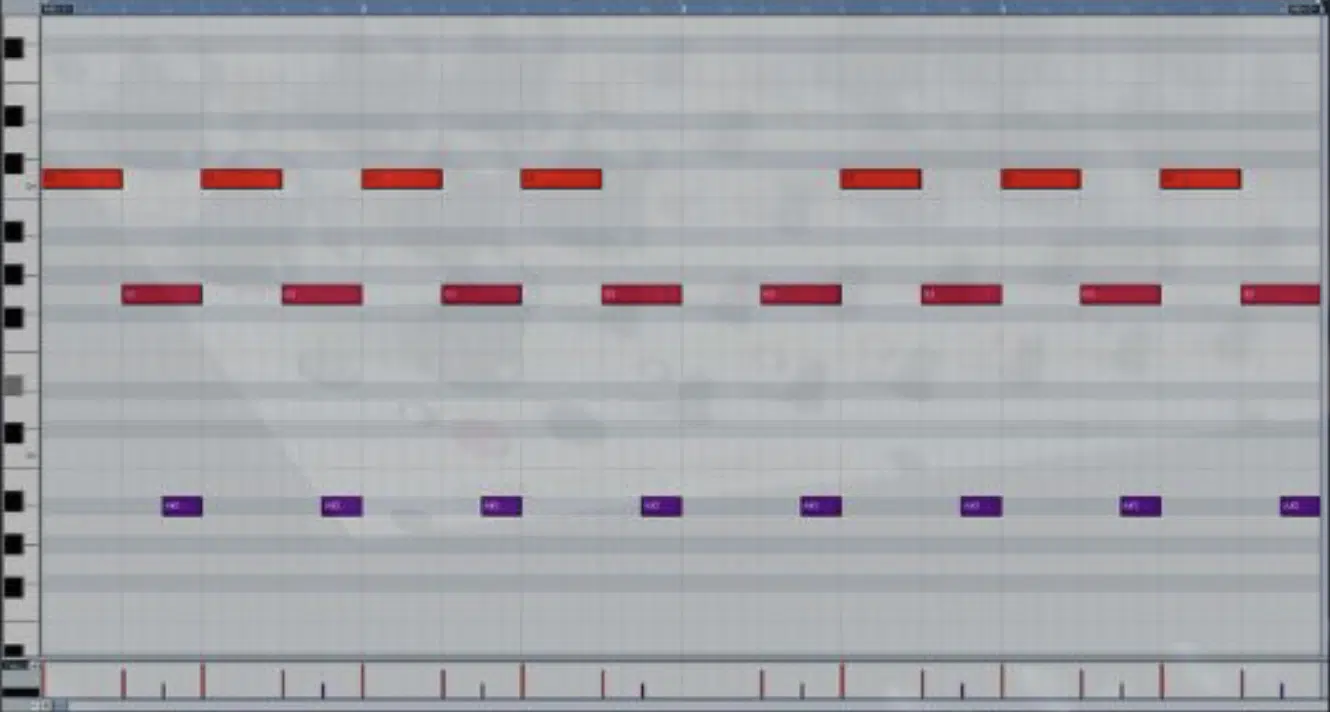
When breaking down what is syncopation in music, missed beat syncopation offers one of the most effective ways to surprise your listeners.
It involves deliberately skipping or “missing” a beat where a note is expected to create a brief moment of silence that adds extra tension.
I’m sure you can see by now, tension is the name of the game.
For example, imagine a drum loop where the kick hits on every beat, but suddenly, it skips the third beat entirely…
This creates a “hole” in the rhythm that makes the return of the next beat feel stronger and really gets people hooked.
A good tip is to use missed beat syncopation in fills or transitions 一 it can make a chorus or drop feel even more powerful when it comes in after a “missing” downbeat.
Hip-hop and trap producers (like Metro Boomin) often use this technique to create off-kilter, unpredictable grooves that make their beats feel unique, so definitely try it out.
For example, in “Ric Flair Drip” (produced for 21 Savage, Offset, and Metro Boomin), the drums skip certain beats to create a stuttering effect that was bouncy as heck.
NOTE: To further refine your understanding of what is syncopation in music, don’t forget to experiment with different note placements.
This way you can see how missing certain beats can affect the overall groove and energy of your track.
-
Suspension Syncopation Rhythms
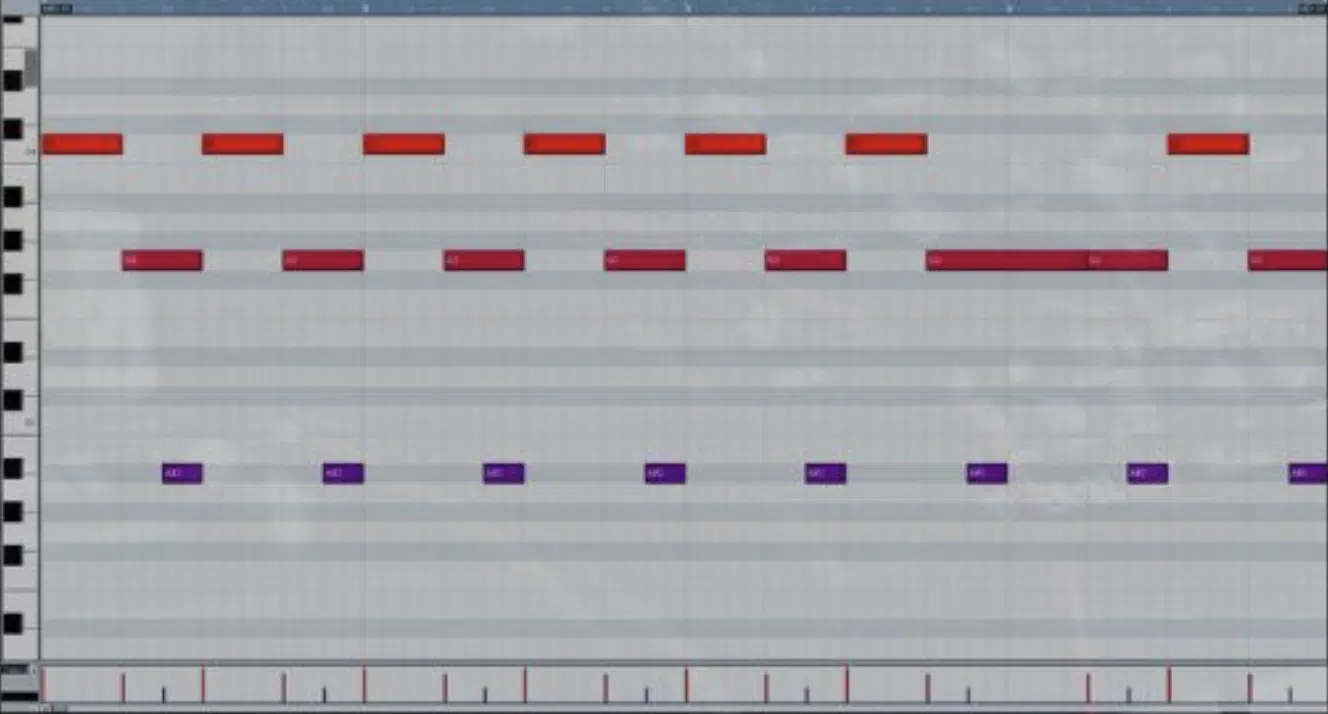
If you want to really dig into what is syncopation in music, suspension syncopation is a more advanced technique that adds a sense of tension and release.
This type of syncopation involves holding a note or chord from the end of one measure into the next, which delays the expected resolution.
Imagine a piano playing a chord on the “and” of the fourth beat in a 4/4 bar and holding it over into the first beat of the next bar…
This will create a hanging feeling and make the listener anxiously wait for the next beat to resolve (remember, it’s all about piquing your listeners’ interest).
It’s often used in jazz or classical music, but can be powerful in pop or electronic tracks to add emotional depth as well, so don’t underestimate it.
For example, think of a track where the bassline is holding a quarter note over the bar line, while the snare lands on the weak beat after, creating a push-and-pull effect.
To master this, try creating a melody or harmony that holds certain notes over beats, then releases them on an offbeat to keep your rhythm hyped up.
By using suspension syncopation, you add a unique layer to your syncopated music, making it stand out and giving your listeners something to feel/hear.
Using Syncopation Techniques
To make your music more epic and show-stopping, understanding how to use syncopation like a pro can be your golden ticket. So, next, let’s break down some techniques will show how syncopated rhythms can really change the game.
-
Syncopated Drum Patterns

When creating syncopated drum patterns, think beyond the standard rhythms where kicks and snares hit on predictable beats.
A great way to add syncopation is by placing a snare or hi-hat on an unexpected offbeat or in between eighth notes to create more movement.
For example, placing a snare on the “and” of the third beat rather than just the second and fourth beats can completely change the groove.
By alternating between offbeat syncopation and regular beats, the rhythm becomes more dynamic, creating that push-and-pull effect we just talked about.
NOTE: To gain experience, practice clapping or tapping out different syncopated rhythms and feel how they alter the overall flow of a beat.
Side note, if you want to learn more about eighth notes, sixteenth notes, note syncopation, etc., make sure to check out our music theory article.
-
Syncopation in Melodies and Basslines
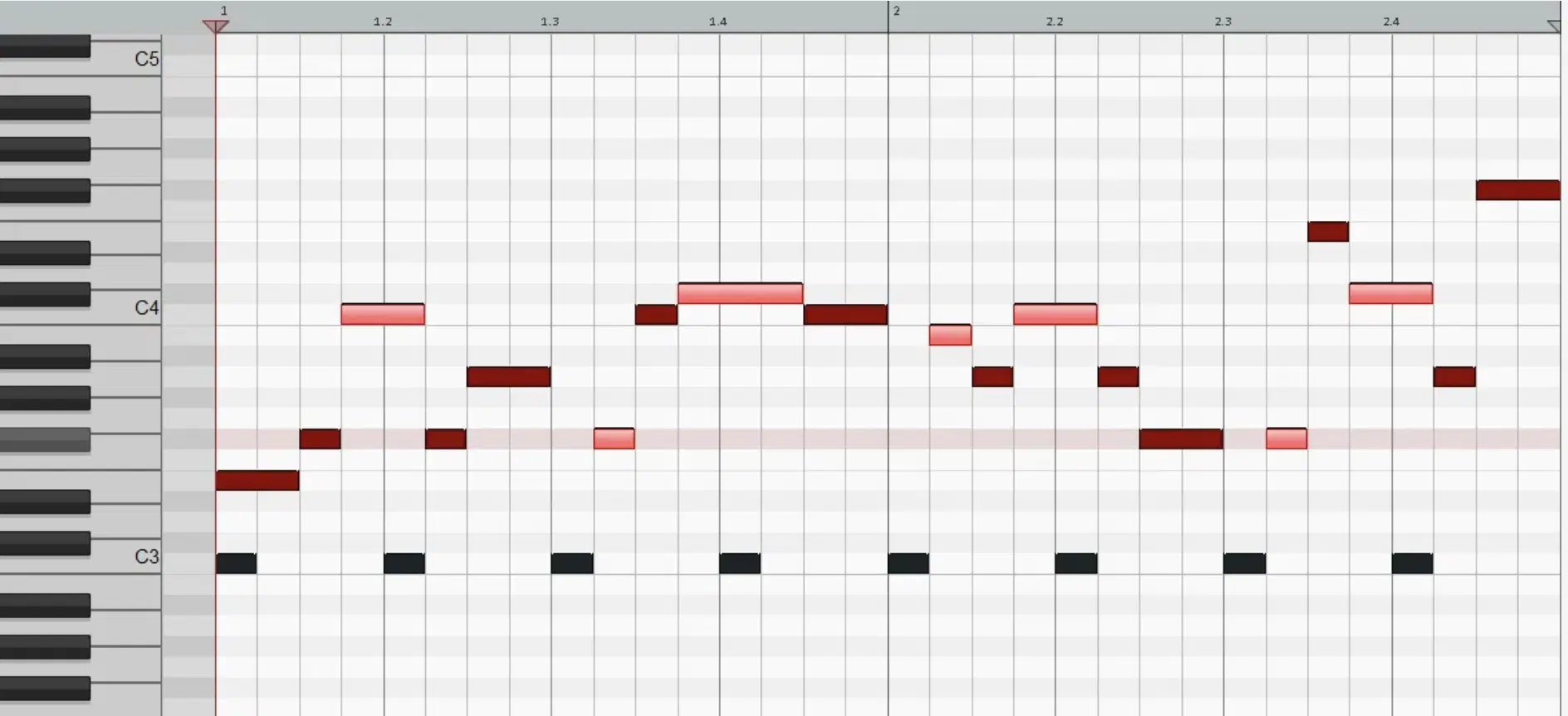
Just like with drums, adding syncopation into melodies and basslines is about placing notes where they aren’t normally expected, especially on weak beats or off beats.
A syncopated note in a bassline might land just after a strong beat, such as on the “and” of the first beat, creating a groove that pushes forward out of nowhere.
A great way to hear this is by listening to how bassists in funk music use syncopated notes to make the rhythm feel more “alive.”
For melodies, try delaying a note that typically aligns with a strong beat to an offbeat to switch things up and add some intrigue.
Experimenting with syncopation in the bassline and melody can help create a call-and-response effect, where each syncopated rhythm complements the other.
It adds complexity to your music that can really make your tracks stand out.
Don’t be afraid to use a rest after a syncopated note to let the sound breathe and to make the next beat feel even more impactful.
Pro Tip: When working with syncopated rhythms in melodies, consider using quarter notes creatively to change the groove. Instead of placing a quarter note on a strong beat, simply try shifting it to an offbeat or weak beats.
This technique can create an unexpected feel and make your melody really pop.
For basslines, try holding a quarter note slightly longer and then releasing into another set of quarter notes to create a rolling, dynamic effect.
This can keep the rhythm feeling alive and engaging for added movement.
-
Creating Syncopated Rhythmic Layers
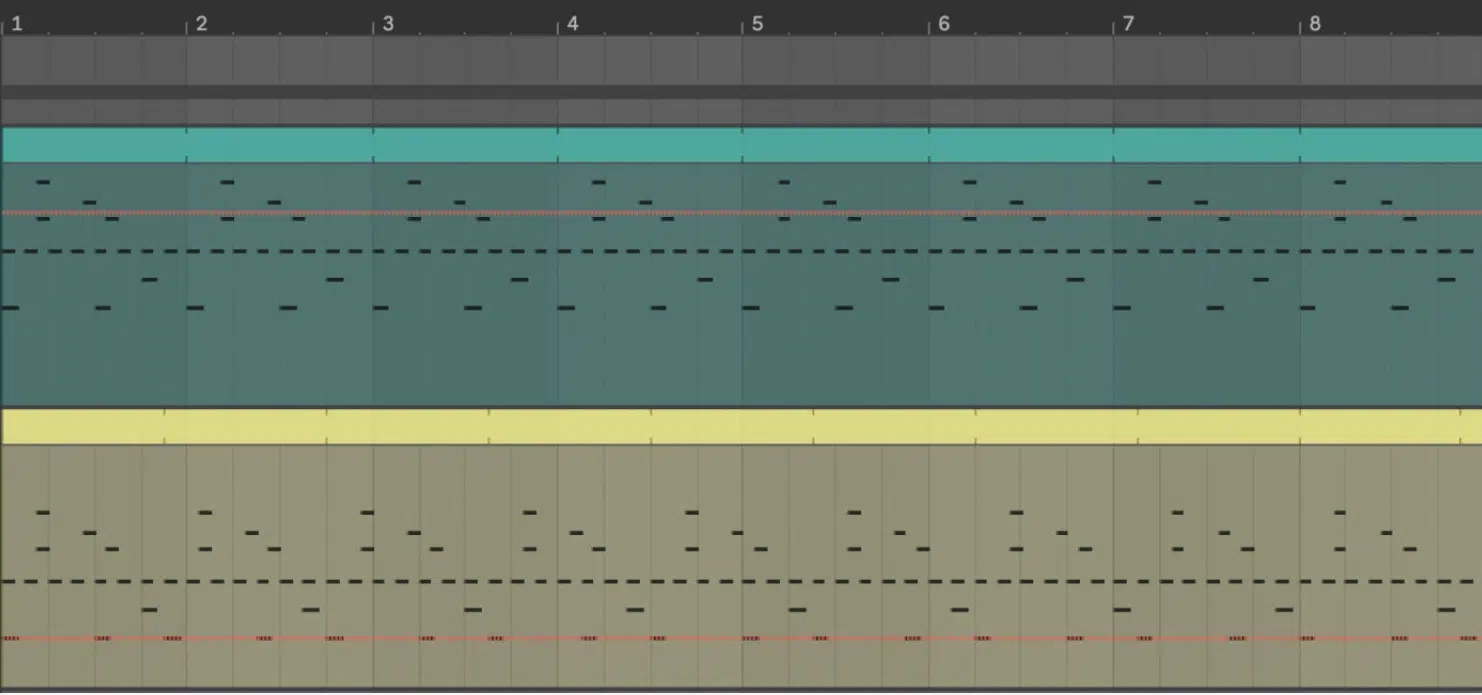
Building syncopated rhythmic layers involves combining multiple syncopated rhythms across different instruments or elements within a song.
- Start with a steady beat on the drums
- Then, add a bassline that emphasizes each off beat
- Layer it with a guitar or synth that plays syncopated rhythms with varying note syncopation
For example, the bass could hit on the weak beat or between eighth notes, while a melodic instrument could follow with a contrasting syncopated rhythm that falls on the first beat and is held over to the next beat.
This creates a complex, fluid texture where each element interacts with the others in an unexpected way.
The key is to ensure that while each layer has its own syncopation, they still work together to create a cohesive groove.
Just keep in mind that too much randomness can cause the rhythm to lose its focus, which you definitely don’t want.
It’s just about finding the balance between complexity and groove to make your music feel both intricate and natural.
Bonus: Advanced Syncopation Techniques for Producers
Once you’ve got the basics of syncopation down, it’s time to play around with some more advanced techniques that can take your music to the next level. They all focus on combining different types of syncopation and experimenting with polyrhythms to create interesting rhythms in your song.
-
Combining Different Types of Syncopation
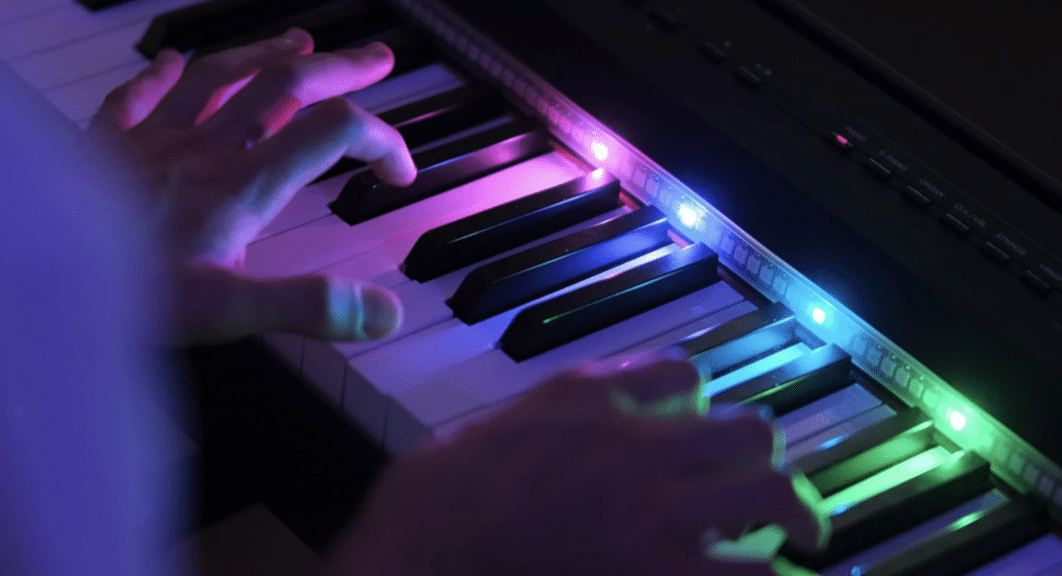
Mixing various syncopation types within a track can be epic, like layering offbeat syncopation in the drums while using missed beat syncopation in a bassline.
The drums might play a syncopated rhythm with a snare on the “and” of every third beat, while the bass drops out on every first beat for a brief rest.
It will give you that moment of silence that tension-filled bangers are made of.
Then, add a melodic element like a piano that uses suspension syncopation 一 holding a note from the previous measure over into the next beat.
This creates a killer tapestry of syncopated music where each part interacts to create a more dynamic and layered feel.
When you play around with combining these different types, you can find new grooves that are both complex and cohesive, making your music stand out.
-
Experimenting with Polyrhythms and Syncopation
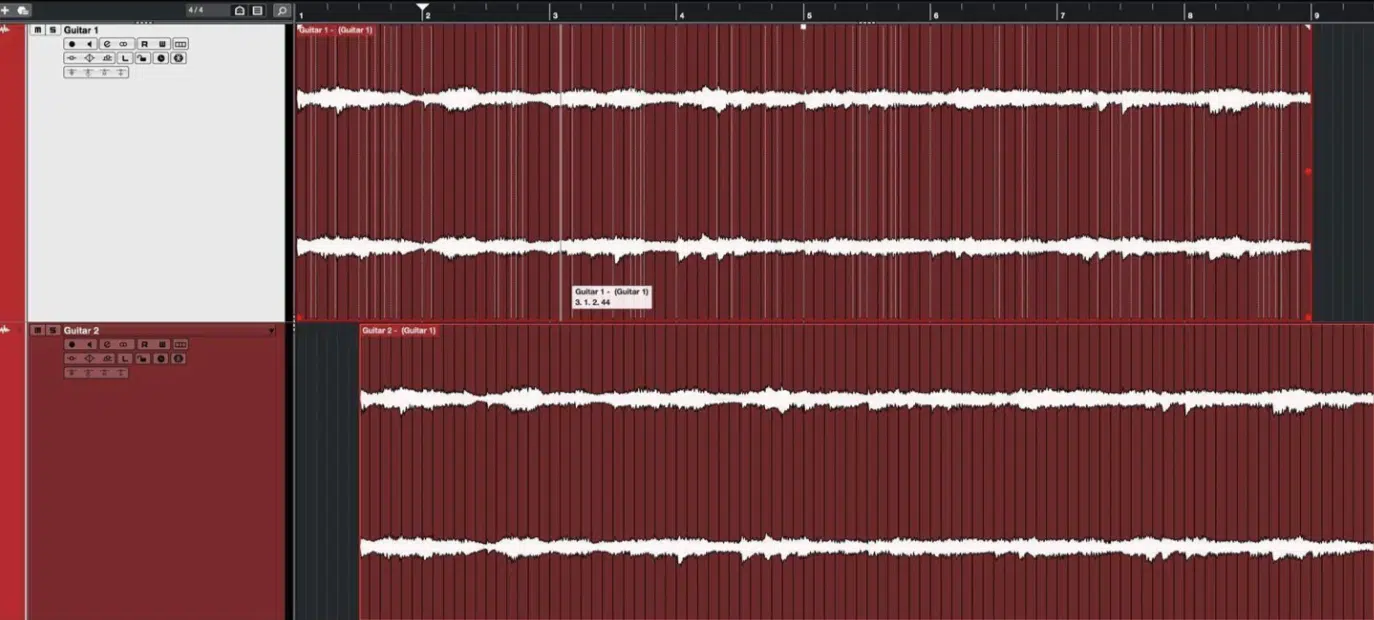
Pairing syncopation with polyrhythms can also give you some incredibly unique and interesting rhythms.
A polyrhythm simply involves playing two different rhythmic patterns simultaneously, such as 3/4 against 4/4.
When you introduce syncopation into these patterns, like having a snare hit on the “and” of the third beat in a 4/4 time signature while the bass drum follows a 3/4 pattern, the resulting groove can feel highly unpredictable yet super satisfying.
This creates a rhythm that seems to cycle and evolve, which is perfect for music genres like jazz, experimental hip-hop, and certain types of electronic music.
To master this, try layering a steady drum loop in 4/4 and then create a syncopated rhythm on top in 3/4 or 6/8 using a different instrument.
The tension and release created by these overlapping rhythms, mixed with syncopated notes, can make your other songs sound far more innovative and engaging.
Talk about blowing the competition out of the water.
What is Syncopation in Music: Final Thoughts
Syncopation, as you now know, is super powerful in shaping the rhythm and feel of your music.
It can add unmatched energy, complexity, and uniqueness to your beats, transforming standard patterns into something much more engaging.
Plus, it has the ability to create tension, drive a groove, and surprise listeners if you know what you’re doing.
By using the tips and techniques in today’s article, you’ll certainly be able to knock out syncopated rhythms and elevate your tracks like a professional.
To help you further understand what is syncopation in music and enhance your skills altogether, you’ve got to check out these Free Essential MIDI Drum Kits.
It contains 5 complete MIDI drum kits, giving you access to high-quality, customizable drum patterns that incorporate a variety of syncopated rhythms.
With these MIDI drum kits, you can easily drag and drop syncopated beats into your DAW, experiment with offbeat syncopation, missed beat syncopation, and more.
All without having to create everything from scratch, which is great.
Whether you’re a beginner or an experienced producer, these kits offer countless opportunities to play around with syncopation, helping you develop a stronger sense of groove and timing.
Now that you have a solid understanding of what is syncopation in music, it’s time to put this knowledge into practice and see how it can transform your tracks.
Just remember to stay creative, keep experimenting, and remember 一 the more you explore syncopation, the more dynamic and engaging your music will become.
Until next time…







Leave a Reply
You must belogged in to post a comment.